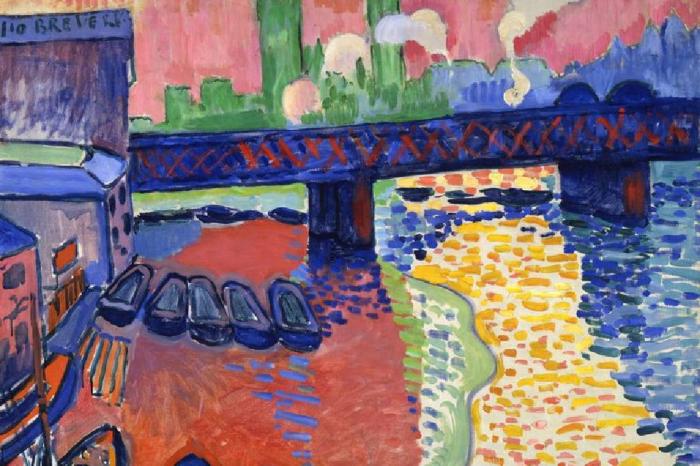The art of the fauves treats color – The art of the Fauves, characterized by its vibrant and expressive use of color, revolutionized the art world in the early 20th century. This avant-garde movement challenged traditional notions of representation, prioritizing the emotional and subjective experience of the artist.
Fauvism emerged as a distinct style around 1905, with artists such as Henri Matisse, André Derain, and Maurice de Vlaminck at its forefront. Their radical approach to color aimed to convey emotions and sensations, often resulting in works that were both visually striking and emotionally resonant.
1. The Fauves
An Overview
The Fauves, meaning “wild beasts” in French, were a group of early 20th-century artists who rejected the traditional norms of painting and embraced bold colors and expressive brushstrokes.
Origins and Etymology
The term “Fauves” was first used by the art critic Louis Vauxcelles in 1905 to describe a group of artists exhibiting at the Salon d’Automne in Paris. The term was meant to be derogatory, but the artists embraced it as a symbol of their rebellion against the established art world.
Key Characteristics and Techniques
Fauvism is characterized by its use of intense, non-naturalistic colors, simplified forms, and expressive brushwork. Fauve artists often applied paint directly from the tube, creating a sense of spontaneity and immediacy.
2. Color in Fauvism
Color was central to Fauvism. Fauve artists used color to express emotions and convey meaning, rather than to depict reality.
Emotional Expression
Fauve artists believed that color could evoke powerful emotions. They used bright, contrasting colors to create a sense of energy and excitement, or muted, earthy tones to convey melancholy and introspection.
Symbolic Meaning
Colors in Fauvism often carried symbolic meanings. For example, red was associated with passion and intensity, blue with tranquility and spirituality, and green with nature and growth.
Examples
- Henri Matisse, “The Green Stripe” (1905): This painting features a woman with a bright green stripe painted across her face, symbolizing her inner turmoil and emotional intensity.
- André Derain, “London Bridge” (1906): Derain’s depiction of the London Bridge uses bold, contrasting colors to create a sense of movement and energy.
3. Fauvism and Other Art Movements
Fauvism had a significant influence on the development of modern art, and its ideas and techniques can be seen in subsequent art movements.
Comparison with Impressionism
Fauvism and Impressionism both emphasized the use of color, but Impressionists used color to capture the effects of light and atmosphere, while Fauves used color for emotional expression.
Post-Impressionism and Cubism
Fauvism influenced Post-Impressionism, which explored the expressive use of color and form, and Cubism, which broke down objects into geometric shapes and planes.
Legacy and Impact
Fauvism challenged traditional notions of beauty and representation, and its bold use of color and expressive brushwork laid the foundation for the development of modern art.
4. Notable Fauve Artists: The Art Of The Fauves Treats Color

Several key artists were associated with the Fauve movement.
Henri Matisse
Matisse was a leading figure in Fauvism and is known for his bold use of color and simplified forms. His works include “The Green Stripe” and “The Dance.”
André Derain
Derain was another prominent Fauve artist. His works, such as “London Bridge,” are characterized by their vibrant colors and dynamic brushwork.
Maurice de Vlaminck
Vlaminck was known for his intense and emotional paintings. His work “The Bridge at Chatou” exemplifies the Fauvist use of bright, contrasting colors.
5. The Art of the Fauves
Techniques and Examples

Fauve artists employed various techniques to achieve their distinctive style.
Brushwork, The art of the fauves treats color
Fauves used expressive brushwork, applying paint directly from the tube in bold strokes. This technique created a sense of spontaneity and energy.
Composition
Fauve paintings often featured simplified compositions, with flat areas of color and minimal details. This allowed the colors and brushwork to take center stage.
Color Theory
Fauves understood the principles of color theory and used complementary and contrasting colors to create vibrant and dynamic effects.
Examples
- Henri Matisse, “The Open Window” (1905): This painting demonstrates Matisse’s use of bold, flat colors and simplified composition.
- André Derain, “The Bathers” (1906): Derain’s painting showcases his vibrant use of complementary colors and expressive brushwork.
6. The Impact of Fauvism on Society and Culture
Fauvism had a profound impact on society and culture.
Challenging Tradition
Fauvism challenged traditional notions of beauty and representation, pushing the boundaries of artistic expression.
Social and Cultural Factors
The Fauve movement was influenced by social and cultural changes, such as the rise of urbanism and the increasing pace of modern life.
Cultural Legacy
Fauvism left a lasting legacy on art and culture, influencing subsequent art movements and shaping the development of modern art.
Questions and Answers
What were the key characteristics of Fauvism?
Fauvism was characterized by its vibrant and expressive use of color, simplified forms, and bold brushwork.
How did the Fauves use color to convey emotion?
The Fauves used color in a non-naturalistic way to express their emotions and sensations. They often employed contrasting and complementary colors to create a sense of tension and energy.
What was the impact of Fauvism on the development of modern art?
Fauvism challenged traditional notions of representation and paved the way for the development of Expressionism and Abstract Expressionism.